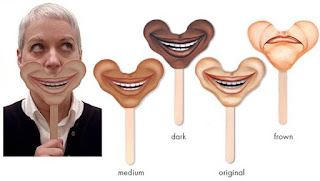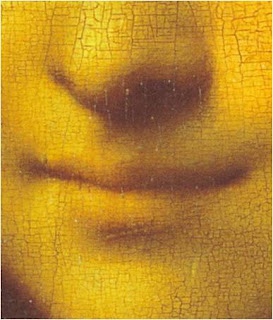WHY DO WE SMILE?
Опубликовано 20.11.2015 - 12:18 - АВАГИМОВА ДИАНА РОМАНОВНА
The question «Why do we smile? » usually brings the puzzled frowns to many scientists who try to discover the elusive origins of grin.
A SMILE costs nothing, but gives much. It enriches those who receive, without making poorer those who give. Yet it cannot be bought, begged, borrowed, or stolen. For it is something that is of no value to anyone until it is given away.
Sometimes we smile to show emotions and sometimes - to hide our real feelings. Fair will notice that how, where and why people are smiling depending on the cultural environment, where they were born. Each culture has its own «code Smiles», which is tacitly accepted in each country.
It’s not easy to trace the evolution of a smile because, unlike teeth or bones, facial expressions cannot be preserved through the centuries. Comparing similar behaviors of different species, scientists have come up with a rather novel story.
Smile is directly descended from the animal world.
John J. Ohala, professor of linguistics at the University of California, Berkeley, holds that our smile is directly descended from the animal world: animals use the smile not because of the way it looks but because of the way it sounds.
The smile, Ohala assets, can modify the sound of an accompanying cry. That is, by pulling back the corners of the mouth and baring the teeth, certain animals are able to emit a whine or yelp that is higher in pitch than the sound they normally produce. This makes the animal seem smaller than it really is and the message it transmits to a potential enemy is: “I’m small and helpless and no threat to you. Leave me along.”
Thus, according to Ohala, the cry that accompanies the smile is a signal of appeasement, submission and non-hostility. In some species the signal eventually evolved into just a visual one. The sound disappeared, the smile itself becoming a symbol of non-aggressiveness. In other species, especially monkeys, the cry remains.
By now, the smile and the frown have become essential tools of communication among humans. The smile is embellished with all kinds of meanings. It is one of the few communication signals that are universal. It is maintained not culturally, but genetically.
Ohala holds that birds and mammals, humans modify their pitch to intimidate their listeners.
It’s interesting to know that one can tell where someone is from just from their smile. One researcher in America believes he really can.
Dacher Keltner, a psychology professor at the University of California, carried out an extensive study into the 43 facial muscles that are used when making a smile.
One of his conclusions was that the smile of people who live in Europe is more sincere and genuine than the smiles of Americans. Mr. Keltner was successful in identifying an American or any other smile when asked to identify which side of the Atlantic Ocean someone was from, just by looking at a photograph. His conclusion was that the average American smile is less expressive because the eye muscles are not part of the smile. Considering this fact, one can immediately start thinking that American smile is not a sincere one, because it’s not reflected in a person’s eyes. Is it really like that? Is the average American smile just a respondent to external stimuli? Does American smile mean anything at all? In the beginning it will be logical to answer the question “Why do we generally smile?”
There are numerous reasons why people smile. They smile out of joy, out of pride, out of embarrassment, and out of contempt. They smile out of politeness, out of courtesy, out of passion, and out of sympathy. Sometimes they smile to show their emotion, and sometimes they smile to hide they true feelings. And, on my point of view, how, when and why people smile usually depends on culture. Different cultures have their own “smiling codes”. In American culture positive feelings are very important. This culture fosters and encourages cheerfulness. It could be seen first and foremost in the American most common mottos: “Cheer up, things could be worse”, “Smile, look on the bright side!” This cheerfulness is inculcated in a person from birth. American parents usually say to their toddlers: „Smile! Look cheerful when you go out in public!” So these children grow up into “automatic smilers”.
In her report for “Psychology Today” Marina Krakovsky says that unlike many Americans, Russians don't put on their happy face for the benefit of strangers.
In fact, Russians seldom crack smiles in public, but that doesn't mean they've come down with "a nationwide case of the blues”. People tend to express less emotion in public because “tamping down emotional displays reinforces the borders between friends and strangers, which in collectivist societies are hard to cross.” In the States, where “relationships come and go more easily,” people tend to be more expressive, even with strangers.
Krakovsky notes that Russians’ straight-faced public demeanor could also have grown out of their rough history or severe climate, for instance.
Why and when Russians and Americans smile.
I shall confine my attention strictly to why and when Russians and Americans smile.
1. Smile in Russian communication is not a sign of politeness.
As you know if you smile at someone, they might smile back.
Russia.
Russian people don’t smile out of politeness. Visa versa, it is considered to be bad to smile without any significant reasons. The Russian phrase “he smiled out of pure politeness” implies a negative attitude to the smiling person.
America.
In America smiles are necessary when greeting or having a polite conversation. Russian writers have pointed out many times that a typical American smile seems non-natural and false to many Russians. They say, “Americans smile as if they are electric lights turned on”, “their smile is something chronic”, “an American face is mainly teeth”. American psychologists say and yet that polite smile inAmerica implies a listener from the problems of protecting the speaker.
2. Russian people do not smile at strangers.
The shortest distance between two people is a smile. I shall subject it to analysis.
Russia.
Russians smile only at their fellow guys. That’s why shop assistants seldom smile at customers (they don’t know them personally!). If a shops-assistant knows a customer she/he will smile at him/her.
America.
Let’s look at the same example. Shop assistants in America always smile at customers (even they don’t know them personally).
3. It is not typical to Russian to give a smile in return.
You’ll probably agree with me that the world always looks brighter from behind a smile.
Russia
We never get a smile back.” It is true: if a Russian person sees a stranger smiling at him he/she is certain to seek the reason of fun. Maybe something in his/her clothes or hairdo makes the gun so cheerful?
An American wrote in the “Izvestiya” paper, “I don’t know why but when looking at Russian custom officers checking our passports and smiling at them we never get a smile in return.
When our eyes meet the eyes of some person walking along a street in Russiawe never get a smile back.”
America
In America culture is a very important positive feeling. This culture encourages and fosters the so-called animal spirits that you can feel by reading or listening to such typical American slogans as «Cheer up! Everything could have been worse», «Smile!
I draw your attention only on the bright side of life!».
This cheerfulness was cultivated in a person from childhood. American parents tell their children: «Smile! Look fun when you find yourself in public!» Thus these children have gradually become «smiling Machines».
4. Russians do not smile when working or doing something serious.
I hope you know the Chinese proverb: «Who cannot smile cannot open the shop».
Russia.
Russian adults tell their kids, “Don’t smile, be serious at school, preparing home task and when grown ups are talking to you!” One of the most common remarks of a Russian teacher is, “Why are you smiling? Stop it and start writing”.
America.
Chase Manhattan Bank has a large note “If your operator didn’t smile you tell the doorman and he will give you a dollar!” I think everything is clear.
5. Russian smile is sincere. It is the expression of either high spirits or a good attitude to a partner.
Russia.
Russians do not smile without reason (for example, to make the mood of a partner better, to make him/her feel pleased or support him/her). One has to really like the person he/she is smiling at or be in very high spirits to have the right for a smile.
America.
Many people believe the U.S. smile is not only «irritating » but also insincere. This rejection occurs because «everyday smiling» is not true for many people especially the Slavs. Russian writers have long defined the American smile as strange and artificial in comparison with Russian. Satirist M. Zadornov called American smile «persistent» but according to M. Zhvanetsky Americans smile as if they are connected to electrical appliances. Gorky wrote that the first thing you will notice when meeting with an American it is his teeth. However it should be remembered that in the American culture of the smile is the first way of politeness.
6. A smile of a person should be reasonable.
Russia.
A smile of a Russian person should have a sufficient reason, which is evident to others. It gives a person the right to smile from others’ point of view. The Russian language has got the unique proverb missing in other languages, “Laughter without reasons is the sign of foolishness”. Western thinking people are unable to understand the logics of this proverb. A certain German teacher got the following explanation of the proverb, “If a person is laughing without reason he has problems with his/her head”. He couldn’t understand it and asked, “Why does the second utterance follow the first one??”
The reason of a smile should be evident and clear to others. If they don’t understand the reason or consider it insufficient for s smile they may break smiling and make a reproof “What are you smiling at?”
America.
Some of the people who were in the states are of the opinion that the Americans smile neither courtesy nor the desire to enjoy. In their view the U.S. smile is only the need to smile just smile.
7. A smile should fit the situation from the point of view of the people around.
The commonest situations of Russian communications do not further smiles. People do not smile in a tense situation. They say, “Not a proper time for smiling”.
It is not considered good to smile near people having serious problems or troubles (if others are aware of them of course): illness, personal problems and so on.
A smile costs nothing but gives much. It enriches those who receive without making poorer those who give. It takes but a moment, but the memory of it sometimes lasts forever. None is so rich or mighty that he cannot get along without it and none is so poor that he cannot be made rich by it. Yet a smile cannot be bought, begged, borrowed, or stolen, for it is something that is of no value to anyone until it is given away. Some people are too tired to give you a smile. Give them one of yours, as none needs a smile as much as he who has no more to give.
From this I can conclude that a smile is one of the most simplest, inexpensive and wonderful things in the world.
Still, often we forget about this one powerful action while we get lost in the details of today and tomorrow. We feel tired and we got too much to do at work and we got to pay the bills and why did I get the grumpiest cashier at the supermarket…
Five reasons to smile.
Thus after carrying out a comparative description and analysis, it is possible to give
5 reasons why smiling as often as you can put more positivity into your life.
1. You will get a boost of happiness – try forcing yourself to smile for thirty seconds right now. The great feelings that make you smile works in reverse too. By making yourself smile, no matter how you feel, your body will start to release all those wonderful chemicals that make you feel happy. Try it right now and feel the difference.
2. A smile changes your state – if you feel frustrated, angry or bored a smile changes your emotional state. And a positive state is not just more fun but also opens up to other possibilities in your mind. You will see the world differently through a happier lens. And then you can start building on that to have a string of positive actions and interactions with other people throughout the day.
3. A smile changes other people’s state – walking into a room or up to the counter in a store with a smile on your face can make a world of difference. People will smile back at you and be more helpful and any social tension or awkwardness will melt away. And your interactions will be more open, relaxed and filled with fun and possibilities.
4. Well, why shouldn’t you smile? – when choosing between a frown, a blank expression or a smile the last choice seems to be the most productive and positive choice, doesn’t it? Sure, often you will forget to smile or maybe you just don’t feel like it. But if you try to remember it and use it more often you will soon develop a new habit.
5. It’s easier to smile than doing the opposite – you actually use less muscles while smiling than while frowning or making an angry face. Well, that’s probably what you have heard at least. But still, if you start smiling more your smiling muscles will soon become stronger than your frowning muscles. And it will become easier and easier to smile than doing the opposite.
To sum up I want to say that I like smiling people!
A smile, even for a while, can bring happiness in the lives of people who are suffering from distress, anxiety or pain. It is so beautiful to smile! Joke everywhere and every day and the world will be joyful and smiling. Smile attracts happiness and no doubt a happy person is a successful person. Keep on smiling to attract more happiness and success in you life.
If this blog
brings a smile to your face then please refer it to your friends particularly to those who have forgotten to smile. Let there be smiling faces all over the world and happiness all around!







